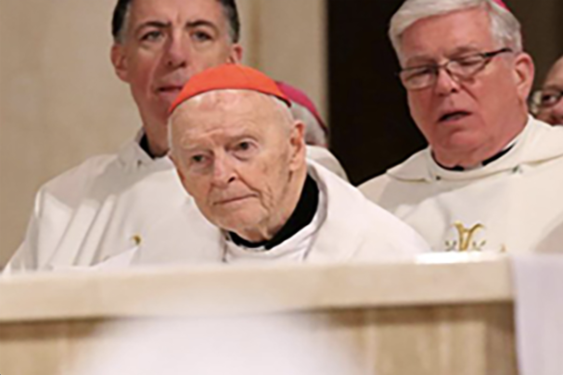
By John L. Allen Jr.
ROME (Crux) – When I took Western Civ in college, our professor once read aloud to the class an excerpt from the diary of a Roman senator written on Sept. 4, 476 AD. The senator described his efforts to suck up to 16-year-old Emperor Romulus Augustulus in hopes of being appointed to some high office, perhaps a tribune or magistrate.
On that same day, Romulus Augustulus, the last emperor in the West, was deposed by the barbarian warlord Odoacer, marking what historians now conventionally identify as the fall of the Roman Empire.
My professor’s point was that quite often, people living through moments that change history fail to recognize them at the time.
[Related: McCarrick Report Summary Cites Lack of Serious Investigations of Rumors]
The point arises with respect to the Nov. 10 release of the Vatican’s long-awaited report on the case of ex-cardinal and ex-priest Theodore McCarrick. While the focus, understandably, has been on the content of what the report contains, the crucial historical point may be the fact it happened at all.
It’s so breathtaking, in fact, that one wonders if anyone in the Vatican actually understands the magnitude of the precedent they just set.
The only comparison that comes to mind dates to August 17, 2011, when the Vatican released roughly 70 pages of documents in its possession regarding the case of Father Andrew Ronan, a Servite priest who was laicized in 1966 and died in 1992 and who later figured in a sex abuse lawsuit in Oregon in which the Vatican was named as a defendant.
Yet in that instance, there were no interviews conducted by a Vatican investigator, no attempt to provide context or explanation, and no admission of failure. All we got were the documents themselves, along with a preemptory declaration by a spokesman that they proved the Vatican completely innocent.
(That may be because the issue in the Ronan case was whether every Catholic priest in the world is a Vatican “employee,” a preposterous notion hard for anyone in the know to take seriously.)
In other words, the Ronan release was profoundly different from what happened with the McCarrick report, which was researched and written by Jeffrey Lena and his colleagues. Lena is a Berkeley-based attorney who’s represented the Vatican on civil matters in American courts for decades and who also knows Italy well, having studied and taught in Milan and Turin.
To grasp the full significance of what’s happened, let’s take a step back. Since 1870, when the Vatican lost its temporal authority and was compelled to become an exclusively spiritual power, operationally it’s had two core principles: Secrecy and sovereignty. Secrecy meant we don’t air our dirty laundry in public in order to avoid scandal, and sovereignty meant we don’t owe an explanation of our actions to anyone.
This report doesn’t just break with those principles, it shatters them forever.
Granted, critics may find it terribly convenient that while the report faults St. John Paul II and Pope emeritus Benedict XVI, it largely insulates Pope Francis from blame. Granted, too, victims and others may object this is an accounting without accountability, and until someone is punished not only for the crime but the cover-up, the work isn’t done.
Still, for the most part the report is searingly honest and comes off as a genuine attempt to get at the truth. It contains a level of detail never before seen. We’re given the strictly confidential advice the most senior prelates in the Church gave when deciding to promote McCarrick, we’re given the gut-wrenching details of victim testimony, and we’re given first-hand recollections by top Vatican officials of the decision-making process. Such disclosure, on this scale, is absolutely new.
The present power structure in the Vatican deserves credit not only for allowing this to happen, but for taking the heat as time wore on and impatience grew. We’ve been wondering for two years why it was taking so long, but seeing how thorough and painstakingly detailed the report is, that question no longer seems quite so pressing.
More basically, think about the precedent this report sets. From now until the end of time, regarding any scandal past or present, if the Vatican refuses to conduct a similar investigation and make the results public, the question always will be: Why not? What are they trying to hide?
If I were a victim of the late Mexican Father Marcial Maciel Degollado, founder of the Legion of Christ, I’d be demanding a similar investigation right now to find out who covered for Maciel in the Vatican and why. If I were one of the alleged victims of Argentine Bishop Gustavo Zanchetta, accused of sexual misconduct with adult seminarians and given a job by Pope Francis in the Vatican’s financial operations, I’d be clamoring for my own McCarrick report to tell me what the pope knew and when he knew it.
One could go on. At the moment, another candidate for such an inquest might be the burgeoning London financial scandal and the charges of financial impropriety against Italian Cardinal Angelo Becciu. Some skeptics believe Cardinal Becciu has been set up as a convenient fall guy for the entire affair, and perhaps only a thorough review on the scale of the McCarrick report could establish what actually happened.
In other words, having decided once that secrecy and sovereignty needed to yield to transparency and honesty, the Vatican will never again have a persuasive excuse not to do the same thing when other failures occur.
In the end, it’s possible the McCarrick report may be remembered as the single most consequential step toward reform during the Pope Francis papacy, not only because of what it reveals about this particular case, but the precedent it sets for how all future cases ought to be handled.
Once the genie of transparency is out of the bottle, that is, it’s going to be awfully difficult to put it back in.
